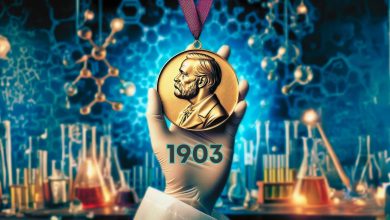
Despite the overwhelming dominance of one group over the other, all was well in the world of the elements. Or so it seemed. Until 1949, that is. That year, a scientist named Maria Goeppert Mayer scientifically explained why some elements stood out more than others: Some were MAGIC!
Is Nature Fair? Proportions of Elements on Earth
When we look at the contents of the earth’s crust, we see the overwhelming superiority of one group over the others. Elements from hydrogen to iron, that is, the first 26 elements, make up 99.7% of the earth’s crust by weight. All other elements can be found only three thousandths by weight. Could it be that these 26 elements are separated into magical ones and “muggle“ ones?
If you’re wondering why the first 26 elements are found more often, We recommend you to read our article, “Where Do the Elements Come From?”.

Apart from that, the earth elements are listed among themselves according to their abundance degrees as follows:
Aluminum: 7.4%
Iron: 4.2%
Calcium: 3.3%
Sodium: 2.4%
Potassium: 2.35%
Magnesium: 2.35%
Hydrogen: 1%
Titanium: 0.6%
This is how the ten most abundant chemical elements on our planet are listed.
The rarest element on earth is Astatine. It is thought that there are only 69 milligrams in the entire earth’s crust.
Why So Much Oxygen?
The fact that oxygen covers almost half of the earth creates a question mark in the minds. As we mentioned in the article “Where Do the Elements Come From?”, hydrogen and helium were formed after the Big Bang. Then the third element, Lithium, was formed. While the most abundant element in nature is H, the second element is He, and the third element is Oxygen instead of Li. Questioning the reason for this, Maria Goeppert Mayer tried to find a connection between them by examining stable elements. When she put this thought into mathematics, she reached a magical conclusion. This magic happens in atomic numbers like 2, 8, 20, 28, 50, and 52.
What Makes These Numbers Magical?
Yes, now we’re getting into the science part. However, before we move on to this part, we need preliminary information about the atom. You may remember it from the chemistry classes in high school. Atoms are made up of electrons, protons, and neutrons. In the center, that is the nucleus, there are electrons around the nucleus and these electrons revolve around the nucleus. But not all electrons revolve in the same orbital.

Think of a time when you were full. That is when you are most calm (or stable). In fact, most of the time, we don’t want to do anything after a meal and lie down. This is exactly how atoms reach these numbers. Completely filled atoms, namely noble gases, do not want to react with any substance because they are very stable.
You’re not you when you’re hungry!
Now let’s think of other atoms that are not fully charged as our hungry stomach. Most of the time, we become more irritable, and aggressive people. These atoms are also in a constant search to satisfy their hunger, so they are not very stable.
Ok, the tough elements are stable. We understand that. However, not everyone can suppress their hunger by eating the same things. As we often see in TV series, the young protagonist drinks half of the orange juice right after eating two bites for breakfast and says that he is full. Another feels full after finishing two loaves of bread for a breakfast with honey and jam. It is obvious that these people have different stomach sizes.

Image Source: Science with Pizzi
Here, the capacities (stomach sizes) of the atoms are also different. These layers are called shells and are always limited to a certain number of electrons. It continues as 2, 8, 8, and 18. Elements in full saturation are noble gases.
Helium = 2
Neon = 2 + 8 = 10
Argon = 2 + 8 + 8 = 18
It continues in this pattern. This distribution of certain numbers is called the “electron shell model“ or the “atomic model“.
The Magical Ones and the Even More Magical Ones
Now let’s get to the reason for the magic numbers. Let’s assume that the “electron shell model” above is similar to protons and neutrons. In other words, a core consisting of shells limited to certain numbers in the same way. That’s what the “core-shell model” basically tells us.
The numbers of protons and neutrons required to fill these shells, which we can imagine these like onion skins, also give us the “magic numbers“. These numbers are as follows: 2, 8, 20, 28, 50, 82, 126.
There are some elements that have the “elder wand” in the magic world. Since both their protons and neutrons are magic numbers, they reach twice the power.
Helium: It has 2 protons and 2 neutrons.
Oxygen: 8 protons, 8 neutrons
Calcium: 20 protons, 20 neutrons
Lead: 82 protons, 126 neutrons
This result explains why there is so much oxygen on earth and in the universe. Also, the fact that calcium is found in our body in a considerable proportion compared to other “muggle” elements is not a coincidence, it’s just magic!
References and Further Reading
Kean, S. (2011). The disappearing spoon and other true tales of madness, love, and the history of the world from the periodic table of the elements. Black Swan.
The Nobel prize: Women who changed SCIENCE: Maria Goeppert Mayer. The official website of the Nobel Prize – NobelPrize.org. (n.d.). https://www.nobelprize.org/womenwhochangedscience/stories/maria-goeppert-mayer.
Vlasov, LN, & Trifonov, DN (1977). 107 Stories about chemistry . Mir Publishers.
Wikimedia Foundation. (2021, July 12). Nuclear shell model. Wikipedia. https://en.wikipedia.org/wiki/Nuclear_shell_model.
YouTube. (2019, January 13). Shell model of nucleus. YouTube. https://www.youtube.com/watch?v=Rd0CJje59bE.
Images not cited are used through Canva Pro with a royalty payment.
The proofreading has been done by Asu Pelin Akköse and Mete Esencan.
Would you like to support us?
- For more detailed information, you can check our “Support Us!” page!







